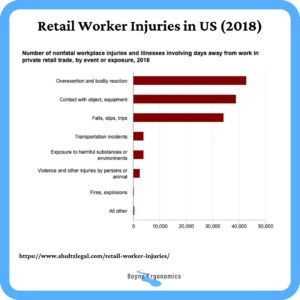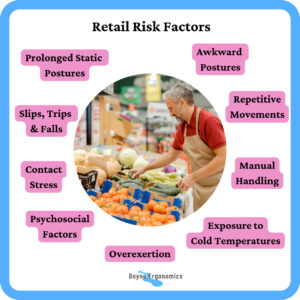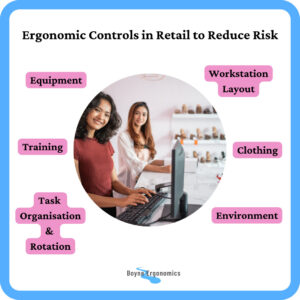In the bustling world of retail, where efficiency, customer satisfaction, and employee well-being are paramount, the concept of ergonomic design plays a pivotal role. From optimizing employee performance to enhancing customer experience, retail ergonomics has the power to reshape the industry landscape.
The retail industry is Ireland’s largest sector, employing approximately 270,000 people. In 2019 it was reported that the Wholesale and Retail sector accounted for 13.5% of non-fatal workplace injuries and was the second highest sector for worker and non-worker accidents.

The most common musculoskeletal issues reported by retail workers are:
- Muscle strain
- Lower back discomfort
- Upper back discomfort
- Tendonitis
- Carpal tunnel syndrome
- Rotator cuff injuries
- Epicondylitis
- Trigger finger
But what is it about retail tasks that pose such a risk to employees?
In this blog post, I outline the risk posed by retail-based tasks, the impact poor retails ergonomics can have on the employee, the employer and the customer, general areas where improvements can be made and the benefits of an employee centred retail ergonomics programme.
Ergonomic Risk to Retail Employees
Retail environments are often fast-paced and demanding. I worked in retail myself when I was in my late teens and I remember it being so physical, I was always on the go.
The ergonomic factors that pose a risk to the health and wellbeing of retail workers can be both biomechanical and environmental.
- Prolonged postures – sitting or standing for prolonged periods, e.g. checkout operators
- Awkward postures – leaning, reaching, bending, twisting, squatting postures that can be observed in a range of retail tasks such as stock replenishment, packing bags, assembling retail displays etc. Poor fitting uniforms (I have been there!) can also contribute to awkward and restrictive postures.
- Overexertion – applying high rates of force during tasks when using tools and completing manual handling tasks
- Repetitive movements – scanning items, cashier tasks, picking and packing orders, data entry, product assembly.
- Manual handling – lifting, lowering, carrying, pushing and pulling tasks that can involve awkward loads.
- Contact stress – contact with hard edges, using hands to bang lids closed, tool handles
- Exposure to cold – handling frozen items, working in cold rooms
- Psychosocial risk factors – high workload, negative customer interactions, long work hours, irregular work hours
- Slip, trip and fall hazards – obstructions, liquid on the floor, uneven flooring, poor lighting, distraction.
Addressing these risks is not just a matter of convenience; it’s a crucial step towards safeguarding employee health and well-being.

The Cost of Poor Workplace Ergonomics for Employers
For employers in the retail industry, the cost of ignoring ergonomic concerns can be significant. Employee absenteeism due to injuries, decreased productivity, lack of trained or qualified staff, cost of training new staff, and high turnover rates can all contribute to substantial financial losses.
Poor workplace ergonomics can also cause decreased motivation / morale among staff, lower efficiency and lower quality of work. This can have a knock on effect on the customer satisfaction and loyalty, as they may be more likely to have a negative experience shopping in the store.
Additionally, businesses may face legal consequences if they fail to provide a safe and ergonomic work environment.
Investing in ergonomic solutions can help mitigate these risks and foster a healthier, more engaged workforce.
Impact of Poor Ergonomics on Customer Experience
Customer experience is the cornerstone of retail success. However, as mentioned above, poor ergonomic design can indirectly impact customers as well.
When employees are fatigued or uncomfortable, their ability to engage with customers may suffer. Slow service, lack of attentiveness, and even negative interactions can result from employees who are struggling with ergonomic challenges.
Ultimately, the customer experience is intrinsically tied to the well-being of the employees.

Improving Retail Ergonomics
Ergonomics is all about fitting the task, environment, service or product to the end user, in this case the employees and to an extent the customers also.
As a starting point, risk assessments should be conducted, by a competent person, to identify the factors present in the workplace that could contribute to the employee developing an injury or musculoskeletal discomfort. These should be kept up to date and reviewed with any changes in location, people, process or equipment.
Employees should be consulted at each step to provide relevant insights and feedback.
Once the risk assessments are complete and relevant factors are identified, the aim is to reduce the risk these factors pose to the lowest possible level. General control measures that are commonly applied include:
- Equipment – e.g. manual handling equipment, power feed converters at checkouts, height adjustable work surfaces, adjustable seating etc
- Training – appropriate onboarding processes should be implemented and recorded to ensure all workers receive adequate training for all tasks and equipment required
- Workstation Layout and Environment – e.g. appropriate lighting levels, positioning of high use equipment to reduce reaching and bending
- Work Tasks and Organisations – e.g. mechanise or automate repetitive functions, work with suppliers to get lighter boxes to reduce the weight that has to be lifted manually, observe the work flow and, if necessary, re-organise it to reduce stress on the workforce
- Clothing – ensure appropriate footwear and clothing is provided that allows for unrestricted movements with layers for individual comfortable temperature control

Benefits of Employee-Focused Ergonomic Programs for Everyone
Employee Benefits
Implementing ergonomic programs demonstrates a genuine commitment to employee welfare. By providing adjustable workstations, ergonomic tools, and training on proper lifting techniques, employees are less likely to experience injuries and discomfort.
This fosters higher job satisfaction, increased morale, and a sense of value, leading to higher retention rates and improved overall well-being.
Employer Benefits
Employers stand to gain immensely from investing in ergonomic initiatives. A healthier workforce translates to fewer sick days and reduced turnover, resulting in lower recruitment and training costs.
Enhanced productivity and improved employee performance are also natural outcomes of ergonomic investments.
Moreover, businesses that prioritize employee well-being often enjoy a positive reputation, attracting top talent and loyal customers.
Customer Benefits
Happy, comfortable employees create a welcoming atmosphere for customers.
Engaged employees are more likely to provide excellent service, answer queries with enthusiasm, and assist customers effectively.
When customers feel valued and attended to, they are more likely to return and spread positive word-of-mouth recommendations.
In the dynamic realm of retail, the significance of ergonomic design cannot be overstated. By proactively addressing ergonomic risks, businesses can create an environment where employees thrive, employers prosper, and customers are delighted. The benefits of ergonomic programs extend beyond individual gains, weaving a tapestry of success that encompasses everyone involved. As the retail landscape continues to evolve, embracing ergonomic principles remains a pivotal strategy for lasting growth and prosperity.
Sources:
Mohd Nasrull, Abdol Rahman and Muhammad Fareez Ahmad Zuhaidi (2017) Musculoskeletal symptoms and ergonomic hazards among material handlers in grocery retail industries. IOP Conf. Ser.: Mater. Sci. Eng. 226 012027
https://www.hsa.ie/eng/your_industry/retail/
European Agency for Safety and Health at Work. (2007) Work Related Musculoskeletal Disorders in the Service and Retail Sector.


